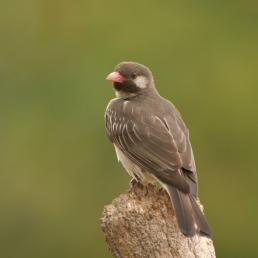

Join BirdNote tomorrow, November 30th!
Illustrator David Sibley and actor H. Jon Benjamin will face off in the bird illustration battle of the century during BirdNote's Year-end Celebration and Auction!
Who knew that this American Redstart’s feathers could reveal so much information about its life? For example, the more intense the color of a male American Redstart’s feathers, the better his chances of holding a good winter territory, which means access to good nutrition. Being well fed and in prime condition, once he gets to his breeding grounds, he’s more likely to attract more than one female, and his mates are less likely to cheat on him. Ah, the many tales one can learn from a bird’s feathers!
BirdNote®
The American Redstart — The Tale Is in the Tail
Written by Gordon Orians, Ph.D.
This is BirdNote.
[Song of a male American Redstart]
Birds are the only animals in the world with feathers. And, it turns out, feathers can tell us much more than just what kind of bird we’re seeing. For example, scientists have learned surprising things about the lives of American Redstarts by analyzing their feathers. [Song of a male American Redstart]
After breeding, redstarts migrate to the Caribbean Islands and Middle America to spend the winter. [Tropical forest, morning ambience] During migration, they molt some of their feathers. Scientists use redstart feathers to determine migratory paths. They can do so because stable forms of hydrogen in rainwater, called isotopes, change with latitude. [Rain falling on vegetation] Hydrogen isotopes are incorporated into the tissues of plants, the insects that eat the plants, and eventually into animals, such as redstarts, which eat the insects. The hydrogen isotopes in redstart feathers tell us the latitude where the individuals were when they grew those feathers. [Song of a male American Redstart]
In addition, the more intense the color of a male American Redstart’s feathers, the better his chances of holding a good winter territory, which means access to good nutrition. Being well fed and in prime condition, once he gets to his breeding grounds, he’s more likely to attract more than one female, and his mates are less likely to cheat on him.
Ah, the many tales one can learn from a bird’s feathers!
For BirdNote, [song of a male American Redstart] I’m Michael Stein.
###
Bird sounds provided by The Macaulay Library of Natural Sounds at the Cornell Lab of Ornithology, Ithaca, New York. Song of the American Redstart [140095] recorded by M. Medlar.
Tropical forest morning Nature SFX Essentials # 36 and soft rain Nature SFX #11 recorded by Gordon Hempton of QuietPlanet.com.
BirdNote’s theme music was composed and played by Nancy Rumbel and John Kessler.
Producer: John Kessler
Executive Producer: Chris Peterson
© 2016 Tune In to Nature.org January 2014/2018/2019/2021 Narrator: Michael Stein
ID# AMRE-01-2014-01-29 AMRE-01
^ Reudink, M. W., Marra, P. P., Boag, P. T., & Ratcliffe, L. M. (2009). Plumage coloration predicts paternity and polygyny in the American redstart. Animal Behaviour, 77, 495-501. doi:10.1016/j.anbehav.2008.11.005







